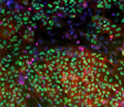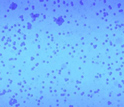News Release 08-155
NSF and EPA Establish Two Centers for Environmental Implications of Nanotechnology
Centers will focus on environmental effects of nanotechnology and its applications

CEIN scientists will study areas like Montana's Berkeley Pit, contaminated by mineral nanoparticles.
September 17, 2008
This material is available primarily for archival purposes. Telephone numbers or other contact information may be out of date; please see current contact information at media contacts.
The National Science Foundation (NSF) and the U.S. Environmental Protection Agency (EPA) have made awards to establish two Centers for the Environmental Implications of Nanotechnology (CEIN).
The centers, led by UCLA and Duke University, will study how nanomaterials interact with the environment and with living systems, and will translate this knowledge into risk assessment and mitigation strategies useful in the development of nanotechnology.
"The new centers will provide national and international leadership in the emerging field of environmental nanoscience," said Arden L. Bement, Jr., NSF director. "This is an important addition to the National Nanotechnology Initiative, and builds on earlier discoveries on the environmental implications of nanotechnology made since 2001, when NSF's Center for Biological and Environmental Nanotechnology was established. The new centers are aimed at strengthening our nation's commitment to research on the environmental, health and safety implications of nanomaterials."
The centers will work as a network, connected to other research organizations, industry and government agencies and will emphasize interdisciplinary research and education. Their challenge is to better integrate materials science and engineering with molecular, cellular, organismal and ecological biology and environmental science.
"The collaborative approach that these centers will use is key to quickly building the scientific foundation for understanding the health and environmental implications of nanomaterials," said George Gray, EPA assistant administrator for research and development. "This comprehensive research model promises to augment the knowledge we need to be good stewards of the environment."
Nanoparticles are as much as a million times smaller than the head of a pin, and have unusual properties compared with larger objects made from the same material. These unusual properties make nanomaterials attractive for use in everything from computer hard-drives to sunscreens, cosmetics and medical technologies.
With the rapid development of nanotechnology and its applications, a wide variety of nanomaterials are now used in clothing, electronic devices, cosmetics, pharmaceuticals and other biomedical products.
The potential interactions of nanomaterials with living systems and the environment have attracted increasing attention from the public as well as manufacturers of nanomaterial based products, academic researchers, and policy makers. Nanotechnology is expected to become a $1 trillion industry within the next decade.
However, the environmental implications of these materials are only beginning to be understood.
The UCLA CEIN, to be housed at the California NanoSystems Institute on the UCLA campus, will explore the impact of nanomaterials on the environment and on interactions with biological systems at all scales from cellular to ecosystem.
At the Duke University CEIN, researchers plan to define the relationship between a vast array of nanomaterials--from natural to man-made to incidental, byproduct nanoparticles--and their potential environmental exposure, biological effects and ecological consequences. Nanomaterials that are already in commercial use as well as several present in nature will be among the first materials studied.
"We are deeply committed to insuring that nanotechnology is introduced and implemented in a responsible and environmentally-compatible manner," said André Nel, Chief of the Division of NanoMedicine at UCLA, who will serve as the UCLA center's director. "We see the UC CEIN as providing an important service to our nation and beyond."
Traditional toxicity testing relies mainly on a complex set of whole-animal-based toxicity testing strategies. "This approach cannot handle the rapid pace at which nanotechnology-based enterprises are generating new materials and ideas," said Nel, who is also the Director of the UC led-Campus Nanotoxicology Research and Training Program at UCLA.
"The CEIN's development of a comprehensive computational risk ranking will allow powerful risk predictions to be made by and for the academic community, industry, the public, and regulating agencies."
At Duke University, "a distinctive element will be the synthesis of information about nanoparticles into a rigorous risk assessment framework, the results of which will be transferred to policy-makers and society at large," said Duke CEIN director Mark Wiesner, Professor of Civil and Environmental Engineering at Duke's Pratt School of Engineering. Wiesner specializes in nanoparticle movement and transformation in the environment.
The Duke research team brings together internationally recognized leaders in environmental toxicology and ecosystem biology; nanomaterial transport, transformation and fate in the environment; biogeochemistry of nanomaterials and incidental airborne particulates; nanomaterial chemistry and fabrication; and environmental risk assessment, modeling and decision sciences.
A major effort for the research team over the coming year is to develop 32 tightly instrumented ecosystems in the Duke Forest in Durham, N.C. Known as mesocosms, these living laboratories provide areas where researchers can add nanoparticles and study the resulting interactions and effects on plants, fish, bacteria and other elements.
"This mesocosm facility will be the nano-environment equivalent of the space station--a unique resource with tremendous potential that will be tapped by researchers throughout the center and beyond," said Wiesner.
"This research will address the influence of nanomaterials on processes ranging from the subcellular to whole ecosystems."
While UCLA serves as the lead campus for the UC CEIN, researchers from a range of other institutions and organizations are involved in UCLA CEIN research, including UC Santa Barbara (UCSB), UC Davis (UCD), UC Riverside (UCR), Columbia University (New York),University of Texas (El Paso, TX), Nanyang Technological University (NTU, Singapore), the Molecular Foundry at Lawrence Berkeley National Laboratory (LBNL), Lawrence Livermore National Laboratory (LLNL), Sandia National Laboratory SNL), the University of Bremen (Germany), University College Dublin (UCD, Ireland) and the Universitat Rovira i Virgili (URV, Spain).
Duke CEIN deputy director Gregory Lowry from Carnegie Mellon University and co-principal investigator Kimberly Jones from Howard University specialize in nanoparticle movement and transformations in the environment. Mike Hochella, a nanogeochemist from Virginia Tech, and Rich Di Giulio, an ecotoxicologist from Duke are also co-principal investigators. Rounding out the team are collaborators Gordon Brown, a geochemist from Stanford University and Paul Bertsch, a soil scientist from the University of Kentucky.
Additional investigators affiliated with the Duke center include those at Clemson, and North Carolina State Universities, as well as scientists at the Environmental Protection Agency, Pacific Northwest National Laboratory, National Institute of Environmental Health Sciences, Army Corps of Engineers and the National Institute of Standards and Technology. International institutions collaborating with the Duke center include the European Center for Research and Education in Geosciences and the Environment; Sciences Po; Buenos Aires Institute of Technology; Nankai University; Swiss Federal Laboratories for Materials Testing and Research; Swiss Federal Institute of Aquatic Science and Technology; and the Institute of Occupational Medicine, United Kingdom.
-NSF-
-
This image shows a "heat map" with increased (red) or decreased (green) stem cell growth
Credit and Larger Version -
New ways of discovering impacts of nanoparticles will be used by CEIN researchers.
Credit and Larger Version
Media Contacts
Cheryl Dybas, NSF, (703) 292-7734, email: cdybas@nsf.gov
Suzanne Ackerman, EPA, (202) 564-7819, email: ackerman.suzanne@epa.gov
Jennifer Marcus, UCLA, (310) 267-4838, email: jmarcus@cnsi.ucla.edu
Deborah Hill, Duke University, (919) 660-8403, email: dahill@duke.edu
The U.S. National Science Foundation propels the nation forward by advancing fundamental research in all fields of science and engineering. NSF supports research and people by providing facilities, instruments and funding to support their ingenuity and sustain the U.S. as a global leader in research and innovation. With a fiscal year 2023 budget of $9.5 billion, NSF funds reach all 50 states through grants to nearly 2,000 colleges, universities and institutions. Each year, NSF receives more than 40,000 competitive proposals and makes about 11,000 new awards. Those awards include support for cooperative research with industry, Arctic and Antarctic research and operations, and U.S. participation in international scientific efforts.
Connect with us online
NSF website: nsf.gov
NSF News: nsf.gov/news
For News Media: nsf.gov/news/newsroom
Statistics: nsf.gov/statistics/
Awards database: nsf.gov/awardsearch/
Follow us on social
Twitter: twitter.com/NSF
Facebook: facebook.com/US.NSF
Instagram: instagram.com/nsfgov




